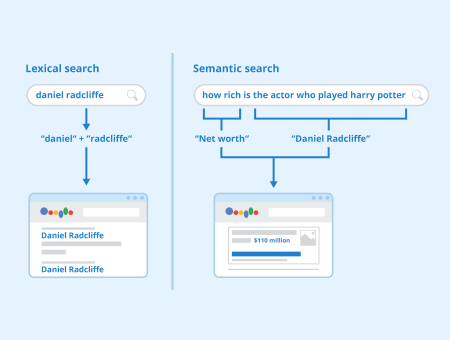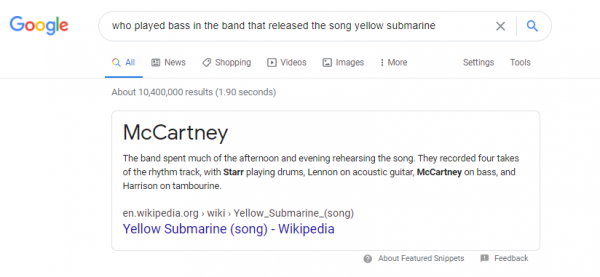What is semantic search?

Semantic search helps search engines like Google to better understand the meaning of a query and display more precise results. To understand its scope, it is useful to compare semantic searches to lexical searches. The latter takes a literal approach to search queries by returning results that match the query words or their variations.
On the other hand, semantic search techniques go beyond literal search terms and focus on the meaning behind each query. By doing so, search engines like Google are able to return accurate results even in instances where users cannot formulate their queries accurately or completely.
Why is semantic search becoming more important?
One of the main reasons behind the growing importance of semantic search is voice search. In this case, the search is mainly performed with whole sentences or longer search phrases. To be able to output fitting search results, Siri, Alexa, Google’s voice assistant, etc. must have access to extensive background knowledge and semantic understanding.
Another important factor is the complexity of language. Irrespective of which language is used, many words are polysemous (i.e. they have multiple meanings), so in order to deliver relevant results, search engines must be able to place query terms in context. Take the word “table” as an example. A search engine needs to be able to differentiate between “table” as a piece of furniture and a mathematical table, and can only do so by placing the query into context. This would not be possible without resorting to semantic analysis.
The fact that we now have the technology that makes this type of search possible is another reason why semantic search is becoming more important. This began to be implemented following the release of Google’s Hummingbird algorithm in 2013, whose main focus was on natural language and context instead of simply scanning content looking for keyword matches. This development has since been complemented with more powerful technology, such as RankBrain (which will be described below) and which is powered by machine learning and artificial intelligence.
In the following example, Google knows who we are looking for, even without us spelling out the name of the band:

Screenshot of a featured snippet for the search “who played bass in the band that released the song yellow submarine” of google.com
Since 2022, the rapid progress of large language models (LLMs) such as OpenAI’s GPT series and Google’s PaLM/LaMDA has given semantic search significant momentum. These models learn from massive amounts of text and can capture the meaning of words, concepts, and even whole passages in very fine detail. Thanks to this, search engines and AI assistants don’t just match words anymore: they can grasp intent, provide clearer answers, anticipate what users might be looking for, and refine results well beyond simple keyword matching.
How does Google’s semantic search work?
Google uses several information retrieval techniques to process search queries. The way queries are handled consists of two parts: first, the engine needs to understand the query and the meaning or intention behind it. Secondly, it must return relevant results. This two-part process is supported by algorithms and technologies that have become more refined in their ability to understand search intent and meaning.
In addition to the technology behind the Hummingbird algorithm, there are other tools that support semantic search. One of them is Google Knowledge Graph, which retrieves data about entities (i.e. topics or concepts) from multiple sources and traces the relationships between those entities.
The underlying idea is the application of semantic mapping, where related concepts are used as interconnected cues that help search engines decode user queries in the most accurate way. Google has access to years worth of query-related user behavior, previous search history, and current trends, and this data can be used to return results that match the user’s intention.
For instance, someone could run a rather vague search query like “Chinese food”. The algorithm carries out a semantic analysis of this query and of the most popular related searches and returns results pages that direct the user to “restaurants serving Chinese food” or “best Chinese restaurants in X location”.
Google also uses RankBrain to support the way its algorithm interprets semantic searches. RankBrain is a set of machine learning technologies that can help the engine decode queries even if they are ambiguous or incomplete.
To handle complex queries, Google also uses BERT, which stands for Bidirectional Encoder Representations from Transformers. This is another machine learning technology developed to process natural language. BERT is used in complex or long search queries and to handle searches that include polysemous words, homophones, etc.
The last aspect underpinning this type of search is semantic coding. This refers to the use of code and in particular of HTML tags that communicate meaning. An example would be the <h1> tag, which is interpreted as the main header and its use can point crawlers to specific parts of a page or blocks of content.
Importance for SEO
The implementation of Google algorithms like Hummingbird had a direct impact on SEO and contributed to the creation of new best practices and recommendations. Before semantic searches became a reality, content created for SEO purposes had to be built around certain keyword-to-word-count ratios. However, nowadays the emphasis is on the relevance of content and in how accurately it reflects the way humans use language in their everyday lives. In short, relevant content must now be written for humans rather than for search engines, even if the ultimate purpose is SEO.
To achieve better positioning, content creators should avoid keyword stuffing and use long-tail keywords and synonyms instead, as these are now understood by search engines that rely on semantic analysis.
Lastly, and due to the importance of semantic coding, website owners and digital marketers are encouraged to take into account certain technical aspects of SEO. This can be done by including semantic HTML and schema markup to support a better SEO positioning.
Developers and SEO experts now have access to tools that rely on semantic analysis and that can help create optimized content that is relevant to users. These tools usually work by suggesting words and key phrases that fit within Google’s semantic analysis model.
The role of LLMs and Google’s new Generative Search
Google first introduced the experimental Search Generative Experience (SGE) in 2023, which used large language models to generate answers at the top of search results. In May 2024, SGE was rebranded as AI Overviews and launched broadly in the United States, later expanding to more than 100 countries by October 2024. In May 2025, Google added AI Mode in Search, building on AI Overviews with more conversational and agentic features.
How does this connect to semantic search?
While semantic search focuses on understanding the intent and meaning behind a query, LLM-powered features like SGE and AI Overviews extend this principle further. Instead of only retrieving semantically relevant documents, they generate summaries by synthesizing information from multiple sources. In other words, they build directly on the advances of semantic search, moving from understanding meaning to producing context-aware answers.
For SEO, this shift has created a new area of practice: Generative Experience Optimization (GEO). Like traditional SEO, the goal is visibility in search results, but now it extends to ensuring that content is well-represented in AI-generated summaries.
Related links
Similar articles
